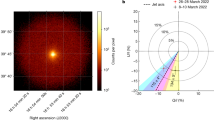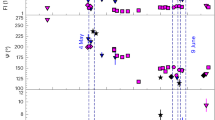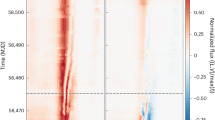Abstract
After the initial burst of γ-rays that defines a γ-ray burst (GRB), expanding ejecta collide with the circumburst medium and begin to decelerate at the onset of the afterglow, during which a forward shock travels outwards and a reverse shock propagates backwards into the oncoming collimated flow, or ‘jet’1,2. Light from the reverse shock should be highly polarized if the jet’s magnetic field is globally ordered and advected from the central engine3,4, with a position angle that is predicted to remain stable in magnetized baryonic jet models5 or vary randomly with time if the field is produced locally by plasma or magnetohydrodynamic instabilities6,7. Degrees of linear polarization of P ≈ 10 per cent in the optical band have previously been detected in the early afterglow6,8, but the lack of temporal measurements prevented definitive tests of competing jet models9,10,11,12,13,14. Hours to days after the γ-ray burst, polarization levels are low (P < 4 per cent), when emission from the shocked ambient medium dominates15,16,17. Here we report the detection of P =  per cent in the immediate afterglow of Swift γ-ray burst GRB 120308A, four minutes after its discovery in the γ-ray band, decreasing to P =
per cent in the immediate afterglow of Swift γ-ray burst GRB 120308A, four minutes after its discovery in the γ-ray band, decreasing to P =  per cent over the subsequent ten minutes. The polarization position angle remains stable, changing by no more than 15 degrees over this time, with a possible trend suggesting gradual rotation and ruling out plasma or magnetohydrodynamic instabilities. Instead, the polarization properties show that GRBs contain magnetized baryonic jets with large-scale uniform fields that can survive long after the initial explosion.
per cent over the subsequent ten minutes. The polarization position angle remains stable, changing by no more than 15 degrees over this time, with a possible trend suggesting gradual rotation and ruling out plasma or magnetohydrodynamic instabilities. Instead, the polarization properties show that GRBs contain magnetized baryonic jets with large-scale uniform fields that can survive long after the initial explosion.
This is a preview of subscription content, access via your institution
Access options
Subscribe to this journal
Receive 51 print issues and online access
$199.00 per year
only $3.90 per issue
Buy this article
- Purchase on Springer Link
- Instant access to full article PDF
Prices may be subject to local taxes which are calculated during checkout



Similar content being viewed by others
References
Piran, T. Gamma ray bursts and the fireball model. Phys. Rep. 314, 575–667 (1999)
Zhang, B., Kobayashi, S. & Mészáros, P. Gamma-ray burst early optical afterglows: implications for the initial Lorentz factor and the central engine. Astrophys. J. 595, 950–954 (2003)
Granot, J. & Königl, A. Simulations of ultrarelativistic magnetodynamic jets from gamma-ray burst engines. Astrophys. J. 594, L83–L87 (2003)
Lyutikov, M. Explosive reconnection in magnetars. Mon. Not. R. Astron. Soc. 346, 540–554 (2003)
Lazzati, D. et al. On the jet structure and magnetic field configuration of GRB 020813. Astron. Astrophys. 422, 121–128 (2004)
Uehara, T. et al. GRB 091208B: first detection of the optical polarization in early forward shock emission of a gamma-ray burst afterglow. Astrophys. J. 752, L6 (2012)
Gruzinov, A. & Waxman, E. Gamma-ray burst afterglow: polarization and analytic light curves. Astrophys. J. 511, 852–861 (1999)
Steele, I. A., Mundell, C. G., Smith, R. J., Kobayashi, S. & Guidorzi, C. Ten percent polarized optical emission from GRB 090102. Nature 462, 767–769 (2009)
Medvedev, M. V. & Loeb, A. Generation of magnetic fields in the relativistic shock of gamma-ray burst sources. Astrophys. J. 526, 697–706 (1999)
Lyutikov, M. The electromagnetic model of gamma-ray bursts. New J. Phys. 8, 119–123 (2006)
Granot, J. The effects of sub-shells in highly magnetized relativistic flows. Mon. Not. R. Astron. Soc. 421, 2467–2477 (2012)
Komissarov, S. S. Shock dissipation in magnetically dominated impulsive flows. Mon. Not. R. Astron. Soc. 422, 326–346 (2012)
Zhang, B. & Yan, H. The internal-collision-induced magnetic reconnection and turbulence (ICMART) model of gamma-ray bursts. Astrophys. J. 726, 90 (2011)
Tchekhovskoy, A., McKinney, J. C. & Narayan, R. Simulations of ultrarelativistic magnetodynamic jets from gamma-ray burst engines. Mon. Not. R. Astron. Soc. 388, 551–572 (2008)
Covino, S. GRB 990510: linearly polarized radiation from a fireball. Astron. Astrophys. 348, L1–L4 (1999)
Greiner, J. et al. Evolution of the polarization of the optical afterglow of the γ-ray burst GRB 030329. Nature 426, 157–159 (2003)
Wiersema, K. et al. Detailed optical and near-infrared polarimetry, spectroscopy and broad-band photometry of the afterglow of GRB 091018: polarization evolution. Mon. Not. R. Astron. Soc. 426, 2–22 (2012)
Baumgartner, W. H. et al. GRB 120308A: Swift detection of a burst. GCN Circ. 13017, (2012)
Virgili, F. et al. GRB 120308A: Liverpool Telescope optical afterglow candidate. GCN Circ. 13018, (2012)
Steele, I. A. et al. RINGO2: an EMCCD-based polarimeter for GRB followup. Proc. SPIE 7735, 773549 (2010)
Beuermann, K. VLT observations of GRB 990510 and its environment. Astron. Astrophys. 352, L26–L30 (1999)
Mundell, C. G. et al. Early optical polarization of a gamma ray burst afterglow. Science 315, 1822–1824 (2007)
Harrison, R. M. & Kobayashi, S. Magnetization degree of gamma-ray burst fireballs: numerical study. Astrophys. J. 772, 101 (2013)
Yonetoku, D. et al. Magnetic structures in gamma-ray burst jets probed by gamma-ray polarization. Astrophys. J. 758, L1 (2012)
Clarke, D. & Neumayer, D. Experiments with a novel CCD stellar polarimeter. Astron. Astrophys. 383, 360–366 (2002)
Bikmaev, I. et al. GRB 120308A: RTT150 optical observations. GCN Circ. 13030, (2012)
Cucchiara, A. et al. Constraining gamma-ray burst emission physics with extensive early-time, multiband follow-up. Astrophys. J. 743, 154 (2011)
Acknowledgements
The Liverpool Telescope is operated by Liverpool John Moores University at the Observatorio del Roque de los Muchachos of the Instituto de Astrofísica de Canarias. C.G.M. acknowledges support from the Royal Society, the Wolfson Foundation and the Science and Technology Facilities Council. A.G. acknowledges funding from the Slovenian Research Agency and from the Centre of Excellence for Space Sciences and Technologies SPACE-SI, an operation partly financed by the European Union, European Regional Development Fund and Republic of Slovenia, Ministry of Education, Science and Sport.
Author information
Authors and Affiliations
Contributions
C.G.M.: instrument science case, observations, scientific interpretation, paper writing lead. I.A.S.: instrument design and build, data calibration. D.K., D.M.A., R.J.S., A.M.: data reduction, analysis and instrument calibration. A.G.: science case, observations, scientific interpretation. C.G., F.J.V., J.J.: observations, data analysis, energy, redshift derivations and afterglow identification. S.K., R.M.H.: scientific and theoretical interpretation. All authors contributed to the writing/editing of the paper and overall scientific interpretation.
Corresponding author
Ethics declarations
Competing interests
The authors declare no competing financial interests.
Extended data figures and tables
Extended Data Figure 1 RINGO2 measurements of Stokes parameters for zero-polarized stars.
Shown is a two-dimensional histogram depicting the distribution of q values versus u values, with bin size 0.002 in both coordinates, for 3,955 objects with r′ < 16 mag detected in ∼2,000 observations of zero-polarized standard star fields. See Supplementary Information for more details.
Extended Data Figure 2 RINGO2 measurement of the polarization of the zenith sky at sunset over a 4′ × 4′ field of view.
See Supplementary Information for more details.
Extended Data Figure 3 RINGO2 measurement of Stokes parameters for all objects in the GRB field.
The complete data set (all temporal bins) has been used. The GRB optical counterpart is indicated in red. The four points with large error bars are too faint (r ′ > 18.5 mag) for reliable measurements to be made. Error bars are given at 1σ confidence. See Supplementary Information for more details.
Extended Data Figure 4 Stokes q and u parameters of all objects in the GRB field versus r′ magnitude.
Error bars are given at 1σ confidence. See Supplementary Information for more details.
Extended Data Figure 5 Polarization evolution of GRB 120308A compared with the four brightest objects 1–4 (Fig. 1) in the field.
The data have been split into the same five temporal bins as presented in the main text. In comparison with the GRB, no significant variation of the comparison objects is apparent. Error bars are given at 1σ confidence. See Supplementary Information for more details.
Extended Data Figure 6 Polarization evolution of GRB 120308A compared with a co-addition of three nearby objects in the field.
In order to enhance the signal-to-noise ratio, the data for objects 5–7 (Fig. 1) have been co-added to produce a source of apparent magnitude similar to that of the GRB. The data have been split into the same five temporal bins as presented in the main text. See Supplementary Information for more details.
Extended Data Figure 7 Polarization degree evolution of GRB 120308A with two different temporal binning schemes.
Shown is original (red) and an alternative co-addition (black) of the data over the time period covered by the first four temporal bins into six bins. The polarization evolution of the optical counterpart is unaffected within the error bars. Error bars are given at 1σ confidence. See Supplementary Information for more details.
Extended Data Figure 8 Polarization angle evolution of GRB 120308A with two different temporal binning schemes.
Original (red) and an alternative co-addition (black) of the data over the time period covered by the first four temporal bins into six bins. The evolution of the polarization angle is unaffected within the error bars. Error bars are given at 1σ confidence. See Supplementary Information for more details.
Extended Data Figure 9 Polarization evolution of GRB 120308A compared with the four brightest objects in the field for alternative temporal binning.
The data have been split into six temporal bins covering the first 305 s of observation. As in Extended Data Fig. 5, in comparison with the GRB no significant variation of the comparison objects is apparent. Error bars are given at 1σ confidence. See Supplementary Information for more details.
Extended Data Figure 10 Spectral energy distribution and best fit model for GRB 120308A.
Flux density at t = 1.44 h after the GRB is plotted as a function of observing frequency. Upper limits are given at 3σ confidence. Error bars are given at 1σ confidence. See Supplementary Information for more details.
Supplementary information
Supplementary Information
This file contains Supplementary Methods and Supplementary References. (PDF 133 kb)
Source data
Rights and permissions
About this article
Cite this article
Mundell, C., Kopač, D., Arnold, D. et al. Highly polarized light from stable ordered magnetic fields in GRB 120308A. Nature 504, 119–121 (2013). https://doi.org/10.1038/nature12814
Received:
Accepted:
Published:
Issue Date:
DOI: https://doi.org/10.1038/nature12814
This article is cited by
-
Gamma rays from a reverse shock with turbulent magnetic fields in GRB 180720B
Nature Astronomy (2023)
-
A deep study of the high–energy transient sky
Experimental Astronomy (2021)
-
A polarized view of the hot and violent universe
Experimental Astronomy (2021)
-
Synchrotron radiation in γ-ray bursts prompt emission
Nature Astronomy (2020)
-
A robotic pipeline for fast GRB followup with the Las Cumbrés observatory network
Experimental Astronomy (2019)
Comments
By submitting a comment you agree to abide by our Terms and Community Guidelines. If you find something abusive or that does not comply with our terms or guidelines please flag it as inappropriate.



